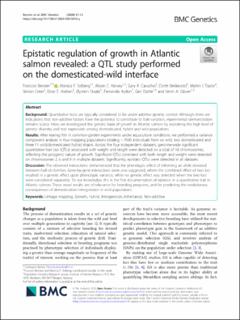| dc.contributor.author | Besnier, Francois | |
| dc.contributor.author | Solberg, Monica Favnebøe | |
| dc.contributor.author | Harvey, Alison C. | |
| dc.contributor.author | Carvalho, Gary R. | |
| dc.contributor.author | Bekkevold, Dorte | |
| dc.contributor.author | Taylor, Martin I. | |
| dc.contributor.author | Creer, Simon | |
| dc.contributor.author | Nielsen, Einar Eg | |
| dc.contributor.author | Skaala, Øystein | |
| dc.contributor.author | Ayllon, Fernando | |
| dc.contributor.author | Dahle, Geir | |
| dc.contributor.author | Glover, Kevin | |
| dc.date.accessioned | 2021-03-15T10:12:59Z | |
| dc.date.available | 2021-03-15T10:12:59Z | |
| dc.date.created | 2020-05-20T14:49:05Z | |
| dc.date.issued | 2020 | |
| dc.Published | BMC Genetics. 2020, 21 (1), . | |
| dc.identifier.issn | 1471-2156 | |
| dc.identifier.uri | https://hdl.handle.net/11250/2733351 | |
| dc.description.abstract | Background
Quantitative traits are typically considered to be under additive genetic control. Although there are indications that non-additive factors have the potential to contribute to trait variation, experimental demonstration remains scarce. Here, we investigated the genetic basis of growth in Atlantic salmon by exploiting the high level of genetic diversity and trait expression among domesticated, hybrid and wild populations.
Results
After rearing fish in common-garden experiments under aquaculture conditions, we performed a variance component analysis in four mapping populations totaling ~ 7000 individuals from six wild, two domesticated and three F1 wild/domesticated hybrid strains. Across the four independent datasets, genome-wide significant quantitative trait loci (QTLs) associated with weight and length were detected on a total of 18 chromosomes, reflecting the polygenic nature of growth. Significant QTLs correlated with both length and weight were detected on chromosomes 2, 6 and 9 in multiple datasets. Significantly, epistatic QTLs were detected in all datasets.
Discussion
The observed interactions demonstrated that the phenotypic effect of inheriting an allele deviated between half-sib families. Gene-by-gene interactions were also suggested, where the combined effect of two loci resulted in a genetic effect upon phenotypic variance, while no genetic effect was detected when the two loci were considered separately. To our knowledge, this is the first documentation of epistasis in a quantitative trait in Atlantic salmon. These novel results are of relevance for breeding programs, and for predicting the evolutionary consequences of domestication-introgression in wild populations. | en_US |
| dc.language.iso | eng | en_US |
| dc.publisher | BMC | en_US |
| dc.rights | Navngivelse 4.0 Internasjonal | * |
| dc.rights.uri | http://creativecommons.org/licenses/by/4.0/deed.no | * |
| dc.title | Epistatic regulation of growth in Atlantic salmon revealed: a QTL study performed on the domesticated-wild interface | en_US |
| dc.type | Journal article | en_US |
| dc.type | Peer reviewed | en_US |
| dc.description.version | publishedVersion | en_US |
| dc.rights.holder | Copyright The Author(s). 2020 | en_US |
| dc.source.articlenumber | 13 | en_US |
| cristin.ispublished | true | |
| cristin.fulltext | original | |
| cristin.qualitycode | 1 | |
| dc.identifier.doi | 10.1186/s12863-020-0816-y | |
| dc.identifier.cristin | 1811955 | |
| dc.source.journal | BMC Genetics | en_US |
| dc.source.40 | 21 | |
| dc.source.14 | 1 | |
| dc.relation.project | Norges forskningsråd: 200510 | en_US |
| dc.relation.project | Norges forskningsråd: 216105 | en_US |
| dc.relation.project | EC/FP7/311920 | en_US |
| dc.identifier.citation | BMC Genetics. 2020, 21, 13. | en_US |
| dc.source.volume | 21 | en_US |

